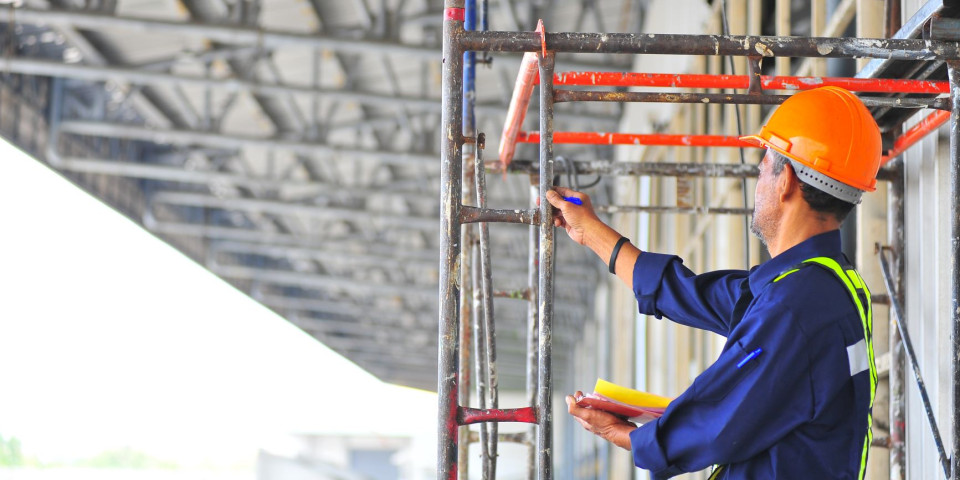Latest News
Scaffold Inspection: What You Need to Know
Posted on Saturday, 4th June 2022

Working in and around scaffolding can be incredibly dangerous if the structures are not in suitable condition for use or have been set-up poorly. This is why it is so vital to perform regular inspections on any scaffolding being used. In today’s blog we take a look at how often you need to be carrying out scaffold inspections on site, who should be performing these inspections and how they can help save lives.
Are scaffold inspections a legal requirement?
If scaffolding could potentially lead to users falling 2 or more metres, it is a legal requirement for inspections to be completed. Failure to do so will mean organisations have failed to protect their workers under their obligations outlined in the Working at Height Regulations 2005.
Inspections need to be regularly carried out on scaffolding to ensure they are stable and secure. Poor setup or damage can result in scaffolding becoming insecure, even when it might initially appear to be stable. This instability could lead to the scaffolding equipment collapsing, causing huge risks to workers operating on or around the structures. As well as causing injuries to workers and members of the public, this could result in serious legal and financial penalties for the company and individuals involved.
How to inspect scaffolding:
The purpose of inspections is to detect any issues with the scaffolding before incidents and injuries have occurred. To do this, inspectors must consider a wide range of factors including the specifics of the scaffolding design, the environment it’s being used in, the tasks the scaffolding is being used for, nearby hazards, and many more factors. The HSE (Health and Safety Executive) has outlined a scaffold checklist of things you need to check and monitor in your inspections.
Who can inspect scaffolding?
To inspect scaffolding on site you need to be a designated ‘competent person.’ This basically means that you have the necessary knowledge, skills and training to carry out inspections effectively. Being the competent person for your site will mean inspections are your responsibility.
If you want to complete training in order perform scaffold inspection at your workplace, why not consider our Basic Scaffold Inspection course? This course will provide all the theoretical knowledge required for learners to inspect scaffolding in accordance with the law. Successful learners will be issued an ESS certificate valid for 3 years. As this training is theory based, it can be completed in person or through video conference training.
While this training will be perfect for many site supervisors, managers and health and safety advisors, some workers may want to complete more advanced training in order to obtain a CISRS card. Ultimately it is down to the employer to determine what level of training is suitable for their workers.
How often must a competent person inspect the scaffold?
Scaffold inspections must be carried out following installation and before their first use. From here, it is integral to continue inspecting scaffolding at regular intervals.
As a minimum, scaffolding inspections should be carried out weekly. Additional inspections should also be conducted any time the scaffolding could have been damaged or altered. This could include exposure to bad weather or being modified by workers.
The Working at Height Regulations 2005 state that “Any equipment exposed to conditions that may cause it to deteriorate, and result in a dangerous situation, should be inspected at suitable intervals appropriate to the environment and use.” These inspections should always be carried out by a competent person who is trained in inspection.
What does CISRS stand for?
CISRS stands for the Construction Industry Scaffolders Record Scheme. This card scheme has been one of the most widely recognised qualifications across the industry since the 1960s. They offer a range of cards that provide the necessary proof for workers across a range of scaffolding-based disciplines, including inspection.
How do I get a CISRS card?
To get a CISRS card you need to have completed a relevant CISRS-accredited course. At ESS, we provide the CISRS Scaffolding Inspection Training Scheme (SITS), which will allow you to apply for the CISRS Basic Scaffold Inspection card.
This 3-day course will provide learners with in-depth knowledge of how to perform checks and sign-off certificates in accordance with working at height regulations. It also includes a practical component where delegates inspection skills will be tested.
If you need to have an understanding of more advanced scaffolding structures, such as complex tube and fitting scaffolds, you may need to hold a CISRS Advanced Scaffold Inspection card. We also provide training for this card through our CISRS Advanced Scaffolding Inspection Training Scheme (SITS Advanced) course.
Certificates for both courses are valid for 5 years, at which point you will need to complete CISRS card renewal. You can check the status of your training and renewal details by visiting the online CISRS card checker via the NOCN website.

At what height do you need fall protection?
For many tasks that involve working at height, it is essential for workers to be equipped with fall protection. These pieces of equipment, such as fall protection harnesses, are the last line of defence to avoid workers falling from height and can be the difference between life and death.
While HSE does not give a specific height that fall protection must be used from, they do demand that if workers are working at height, they need to have a form of fall protection. This could involve working above floor level, near edges or on fragile surfaces. Find out more about this topic by reading our blog ‘ESS Guide to Working at Height’.
There are many different options when it comes to fall protection equipment, with each one having specific features and uses.
As with any health and safety equipment, these tools are only useful if the user has had the appropriate training. Our Personal Fall Protection Equipment Inspector Course will provide the necessary training for you to use a range of fall protection systems effectively on site. Find out more by reading our blog 'Why Safety Harness Training is Critical for Anyone Working at Height’.
What qualifications do scaffolders need?
The qualifications you need to become a scaffolder will depend on the level of seniority of the job you’re applying for and the responsibilities you would undertake. To start out in a junior position, you may only need a couple of GCSEs or equivalent.
If you are interested in starting a career as a scaffolder, we would recommend reading the National Career Service’s guide. It may also be useful to browse job sites such as Reed and Indeed to see what employers are looking for in terms of qualifications and experience for scaffolders.
Contact us:
If you want to know more about any of the training we offer, why not speak to our team by calling us on 0115 897 0529. You can also email us on info@essentialsiteskills.com.


